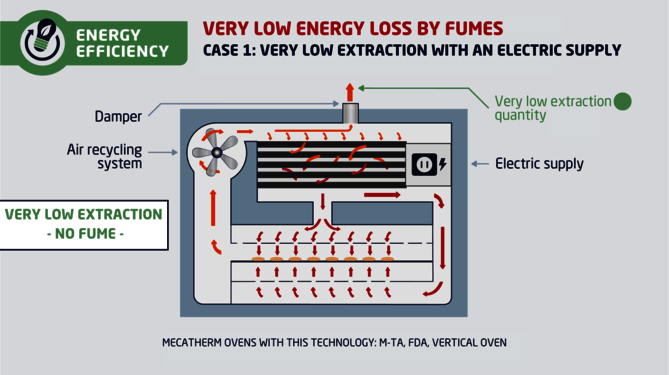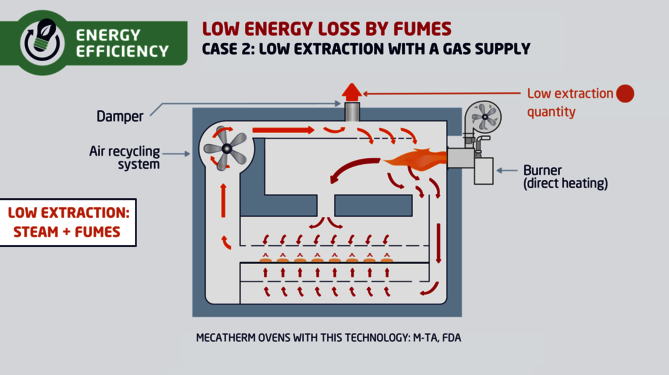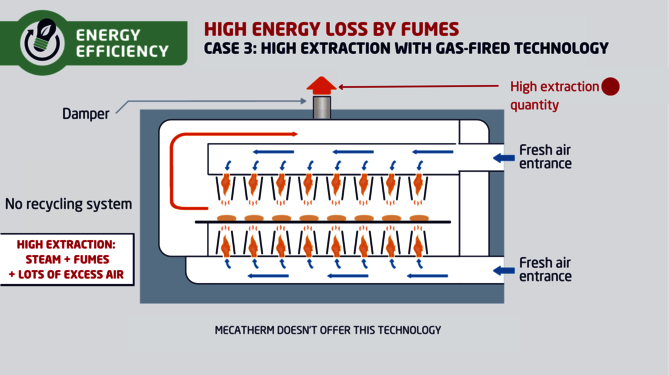Limit the loss by fumes: 4 key parameters
As energy transition continues to be a key issue, MECATHERM is determined to accelerate its efforts in the field of sustainable development by supplying energy-efficient equipment. One of the ways MECATHERM is overcoming this challenge is by supporting customers who want to optimize their energy consumption and prevent energy loss.
In this fourth article on the subject, our expert Hicham MAIDEN, R&D & Thermal Project Manager, takes a closer look at the parameters on which manufacturers can act to reduce energy loss by fumes during the baking stage.
First, it's important to understand how energy consumption is distributed during the backing process. Overall, the total energy consumption during baking is always divided among useful energy (product, support), lost energy (walls, belt, fumes), and energy related to oven usage (such as airflow management, for example).
Thermal energy lost during baking can occur through the oven walls, conveying belts, and fumes. “Energy loss by fumes essentially depends on the quantity of fumes extracted and their temperature,” explains Hicham.
Here are the four key parameters for reducing energy loss by fumes:
Energy transfer mode
Thanks to its greater heat transfer efficiency, convection heating enables products to be baked at significantly lower temperatures than radiant heat, thus lowering the temperature of the fumes generated. In this way, convection baking can reduce energy loss due to fumes by up to 40% for industrial bakery temperature ranges.
Direct or indirect heating
Direct heating is a more efficient method of energy exchange than indirect heating in terms of energy efficiency. Indeed, direct heating (or heating by mixing fumes and air) takes full advantage of the fumes’ energy and avoids the loss of thermal efficiency associated with the use of an exchanger in the case of indirect heating. The presence of an exchanger results in higher fume temperatures and, consequently, higher heat loss (a phenomenon amplified in the case of a low-efficiency heat exchanger).
It should be noted that for direct heating configuration, MECATHERM strategically positions the fume extraction where it is coldest to further minimize energy loss.
Heat transport circuit
An oven equipped with a heat recycling circuit minimizes the quantity of fumes extracted compared to an oven with a direct flame (flame present in the baking chamber).
Why? A direct-flame oven requires a large amount of fresh air from outside to fuel combustion and obtain a suitable temperature for baking products. This generates an important quantity of fumes which are evacuated without being reused.
In the case of heat recycling, the recycled air is simply reheated before being re-injected into the baking chamber. The fresh air consumed is only used to fuel combustion, which then generates a low quantity of fumes.


Electric heating
The most effective solution for limiting energy loss by fumes is to eliminate them by replacing the burner with an electric heater or to greatly reduce them with a hybrid heater.
MECATHERM's range of vertical ovens, as well as its M-TA and FDA tunnel ovens, are compatible with electric heating without any change in product baking quality. The M-TA and FDA oven ranges are also compatible with hybrid heating.

To conclude, MECATHERM ovens are designed to minimize energy loss by fumes by:
1. Using convection as the main or complementary heating mode
2. Using direct heating as a priority or incorporating highly efficient thermal exchangers for indirect heating technologies
3. Systematically using heating circuits with air recycling
4. Electrifying the heating system, which is compatible with the majority of our ovens
MECATHERM offers its customers a wide range of opportunities to optimize energy consumption, supporting them on their journey to become key players in the energy transition movement.
Interested in learning more about this topic? Read our article about how to minimize energy loss through the conveyor belt of an oven.
And to explore more of our sustainable solutions, send us a message.



